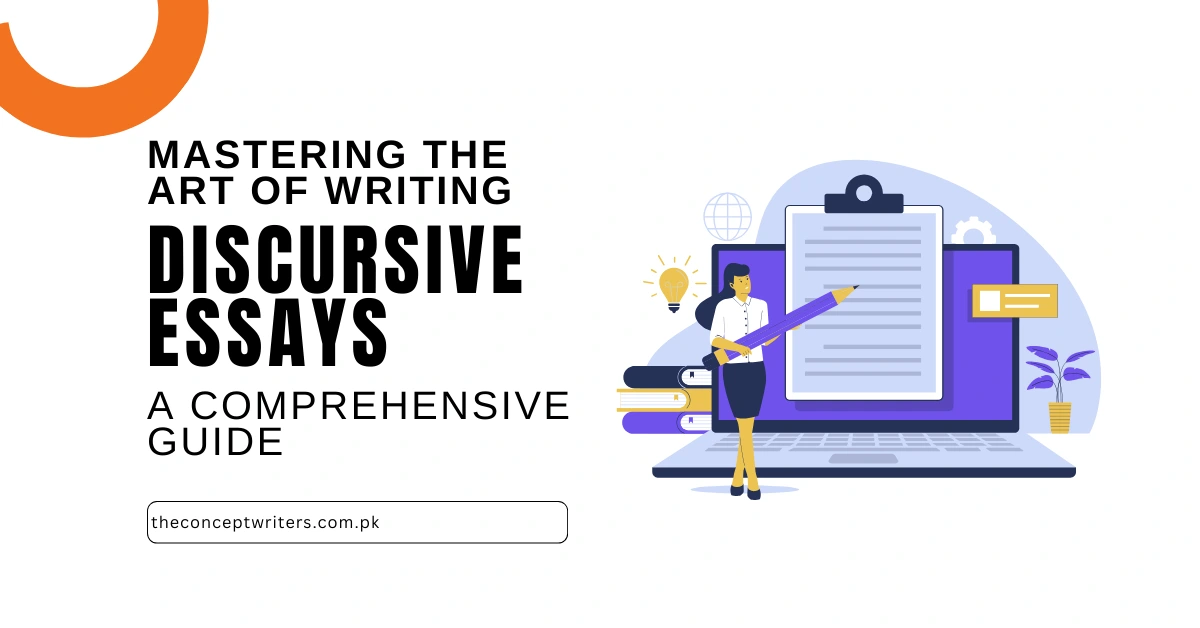Mastering the Art of Writing Discursive Essays: A Comprehensive Guide
How to Write a Discursive Essay?
A discursive essay is a type of writing that presents and discusses different opinions on a given topic. It is a piece of writing that asks you to investigate a topic and present your position based on the evidence gathered.
Discursive essays are written in a formal style. The main aim of a discursive essay is to provide an overall understanding and exhibit numerous opinions on the topic instead of just focusing on one point. This is a form of writing which explores and elaborates an idea in several ways.
This approach to writing will sharpen your cognitive and writing skills. This form is completely different from the persuasive essay in which we are supposed to persuade a reader of an idea, or opinion. We can depict both sides of the picture following this method.
In my point of view, it provides freedom of opinion and expression. It is also important to organize the structure of the essay, with each paragraph building up on the previous one.
Types of Discursive Essays
Two fundamental categories of discursive essays exist. First, there are persuasive essays where you can make a compelling case for or against a particular topic. As an alternative, you can write argumentative essays that present a fair analysis of a debate subject.

Need your Academic Tasks ASAP?
Need assistance with your Academic Tasks? Help is on the way!
Significant Differences between Argumentative and Discursive Essays
The purpose of argumentative writing is to persuade the reader that your point of view is reasonable and merits consideration alongside other viewpoints.
The following procedures are typically included in writing an argumentative essay:
- 1. Provides adequate proof, believable facts, and pertinent arguments in favor of a strong and valuable point of view.
- Researching a subject and supporting a side are the first steps in producing an argumentative essay.
- It is crucial to acknowledge the existence of competing viewpoints while writing an argumentative essay to prove that you are reasonable and to support your position with evidence.
- You are demonstrating more than just your fair-mindedness when you acknowledge the opinions of others. However, you will also have the chance to politely refute their viewpoints and provide evidence for why you think your own is the superior one. The author offers a variety of viewpoints despite her views.
The goal of discursive writing
- Generally speaking, discursive writing uses the following strategies: an effort to persuade the reader that the writer is “right” by fusing sentiment with facts. Opinions frequently have a big impact.
- The first step in discursive writing is to select a topic and a side.
- Discursive Essays have a singular objective. A person believes that their particular method of thinking is the only rational way to think. Only his side of the tale is told by the author. In discursive writing, there might be one opposing position, but it is swiftly disproved.
- Discursive writers are more aggressive in their pursuit of readers because they want to receive another “vote”. Writing that is discursive has a great deal of passion, emotion, and connection.
Structure of Discursive Essay
The structure for a discursive essay is as follows:
- Introduction: One can start by defining the topic and background. Secondly, mention the main issue that you will be discussing in the essay. Moreover, do state some different viewpoints on the topic to be discussed in detail later on.
- Body Paragraphs: Moving to the body of the essay, present different arguments and views regarding the topic. The body can contain multiple paragraphs. Each paragraph must contain a clear and concise statement for an argument that will be discussed in the paragraph. The supporting evidence and proofs should corroborate the argument. Make sure to admit counterarguments and consider other opinions as well.
- Conclusion: Try to conclude by summarizing the main arguments presented in the essay. One can conclude by discussing the argument one finds the most important but also acknowledge that there are different opinions on this task at hand. Therefore, only draw tentative conclusions. End the paragraph with an open-ended question.
Here are some crucial guidelines to assist you in structuring your paper:
- Make careful you utilize distinct paragraphs at all times. Although it may seem apparent, if you don’t know how to utilize a paragraph, your thoughts will become disorganized very fast.
- Make good use of your opening paragraph. Write your hypothesis in the opening paragraph. Writing discursively isn’t the same as creative writing. The goal is to communicate the information clearly and concisely. Your readers may become disinterested if they have to read more than one paragraph to comprehend what you are discussing.
- Explain HOW you want to make your claims in the second paragraph. This will help the readers locate the points by providing a “roadmap” of your ideas. To aid you along, refer to the primary ideas from your essay outline.
- Create strong arguments in your body paragraphs. Your essay’s major body is where you should go into great detail on the subject.
- Compose a single thought in every paragraph. Anything more than one concept in each distinct paragraph begins to become unclear.
- Write a brief conclusion that neatly summarizes everything. Although body paragraphs are excellent, they must be connected in the conclusion.
The structure formation of discursive essays comes to an end. We move forward to the key factors that help in writing a discursive essay.
Key Factors of a Discursive Essay
- Choose Your Topic Carefully
However, selecting a discursive essay topic requires taking into account a variety of viewpoints. In addition to gathering knowledge about the subject from research papers, you also need to be able to organize a meaningful discussion that flows from one thought to the next. As a result, more proactive preparation is needed.
- Comprehensive Understanding
A detailed and complete understanding of the topic is required before putting pen to paper. This is because we will have to discuss different opinions relating to the topic. Discussing the advantages and disadvantages of every characteristic that is relevant to the subject. Differentiating the attributes and qualities of the topic to draw a picture that is acceptable to every reader.
- Research Proficiency and Critical Thinking
Writing a discursive essay is a time-consuming process. It requires concentration and research proficiency. To start with, one needs loads of data to process and filter. So that we can establish our point of view and conclude with the data available.
- Brain Storm Ideas
This by far is the toughest job for an individual. The need is to brainstorm creative ideas and the ones relevant to your essay. To bridge the gap of comprehension between the reader and the writer. This a make-or-break situation. The better the content of ideas is the greater the impact of the essay shall be.
- Prepare First Draft
A discursive essay is a long process. A first draft is always helpful in the later stages. Hence, try to write bullet points, rough sentences, and headings that can act as a reminder. This rough draft is useful to keep an eye on all the points to be discussed in the detailed version.
- Builds Curiosity
Writing discursive essays builds the curiosity of an individual. It develops creativity and nurtures developing opinions related to the topic. It engages in thought-provoking ideas and broadens our horizons.
- Purpose and Audience
The purpose of a discursive essay is to inform and engage an audience. Secondly, a writer should always recognize their target audience and their intellectual capacity. This trait will ease the job of the writer and the reader as well. Always write with emotions and empathy and it will create an impact on the reader’s mind.
- Select Related Ideas
The writer should try to connect all the ideas. Therefore, if it’s possible one should select ideas that are related to one another. Through this process, a complete understanding of the topic can be conveyed easily. This can count as an advantage for the reader.
- Plan your Response
There is an imminent need to plan your response before actually making up your main arguments in the essay. It should be backed up by strong evidence and sufficient knowledge.
- Claims and Counter Claims
While writing a discursive essay make sure to mention the pros and cons of the job at hand. Arguments and counterarguments must be stated with one against another to show both sides of the story before the reader makes up their mind.
- Use Figurative Language
Sometimes literal words are not enough to convey the main theme, therefore to provide a more vivid picture figurative language is used. Similes and metaphors can be employed to excite and motivate the reader. This will help to demonstrate a deep understanding of the topic.
- Be Unbiased
It should be the author’s prerogative to remain unbiased while making every point and counterclaim as well. Clearly state facts from every perspective. Keeping the tone and voice of the essay distinct.
Let our professional concept writing company in Pakistan take the burden off your shoulders! Our team of seasoned writers specializes in delivering top-notch assignments, meticulously tailored to meet your requirements and exceed your expectations.
Rules for a Discursive Essay
- Use formal language.
- Each paragraph needs to have a topic sentence.
- Keep your main body paragraphs focused and concise.
- Allow adequate time for finishing your essay. Finishing the assignment faster is not the best scenario.
- Don’t overlook writing a summary.
- This is not the place to express your personal opinions in a discursive essay.
- An effective writer conveys their ideas clearly; pay attention to it.

Conclusion
Discursive essays tend to link multiple points, but argumentative essays utilize logical reasoning to defend facts. This is one of the key distinctions between the two types of essays.
The structural formula represents the other distinction. The opening paragraph of an argumentative essay should contain the thesis statement. Lastly, the reason an argumentative essay is convincing is that you anticipate the reader will agree with your position after the essay.
Need your Academic Tasks ASAP?
Need assistance with your Academic Tasks? Help is on the way!
FAQ’S
- How many discursive essay attempts should one make?
One shouldn’t limit how many tries you take to write a discursive essay correctly. It is a good idea to allow adequate time after writing your essay so that you may go back and review it. Try again with a new draft if needed, or at least make the necessary modifications. It’s usually a good idea to let it rest and reread it with a new perspective the following day.
- What is the difference between a discursive essay and an argumentative essay?
Although there are some minor variations between the two, the primary distinction between discursive and argumentative essay writing is that the former is objective, whilst the latter aims to persuade the reader of a particular point of view.
- How do you know if an essay is discursive?
A discursive essay can be recognized by its content. If an essay presents both sides of a debate and does so without displaying any bias, it is considered discursive.
- What makes a good discursive essay?
Presenting both sides fairly and coming to some educated guesses about the evidence offered are the objectives of a discursive essay. List the advantages and disadvantages to help you formulate your claims and counterclaims. There should be an equal number of cons for every pro.
- What is the aim of a discursive essay?
A discursive essay’s main goal is to persuade the reader that the position you’re taking is sound. Discursive essays would therefore be a common undergraduate assessment method.



